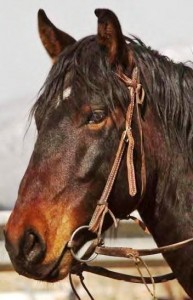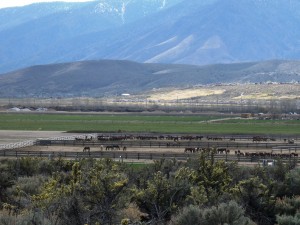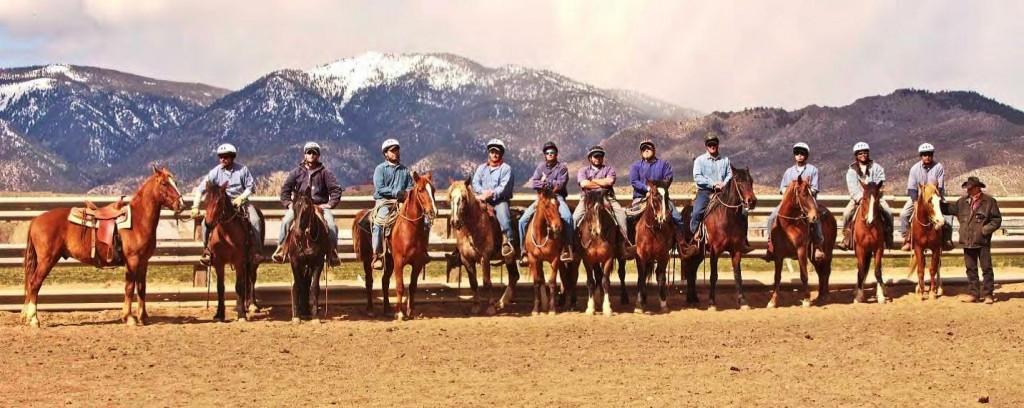» posted on Wednesday, April 25th, 2012 by Linda Lou Burton
Gentling
 Linda Burton posting from Carson City, Nevada – “I look for intelligent eyes,” Hank Curry told me, as we talked about the saddle-trained horse adoption event coming up May 19. Hank has headed the wild horse saddle-training program at the Northern Nevada Correctional Center for 10 years now. “We have as many as 1,100 horses at one time in our feed lot,” he continued, “but the ones we prepare for adoption need to be trainable and healthy.” The program is a cooperative partnership between the Bureau of Land Management (BLM), the Nevada Department of Corrections, and the Nevada Department of Agriculture, and gentles and trains about 60 wild horses a year. I wanted to know about the trainers too; “How do you build your training team?” I asked.
Linda Burton posting from Carson City, Nevada – “I look for intelligent eyes,” Hank Curry told me, as we talked about the saddle-trained horse adoption event coming up May 19. Hank has headed the wild horse saddle-training program at the Northern Nevada Correctional Center for 10 years now. “We have as many as 1,100 horses at one time in our feed lot,” he continued, “but the ones we prepare for adoption need to be trainable and healthy.” The program is a cooperative partnership between the Bureau of Land Management (BLM), the Nevada Department of Corrections, and the Nevada Department of Agriculture, and gentles and trains about 60 wild horses a year. I wanted to know about the trainers too; “How do you build your training team?” I asked.
 “It’s a gut feeling, really,” Hank said. “This is a medium security prison; inmates here are not guilty of violent crimes. I look for men who are used to working long hours, and won’t mind getting bucked off, or bumped against the fence. Maybe they’ve worked construction, or played football in high school. And they have to be here for at least a year. Of course they volunteer to work with this particular program, we have a dairy here too, and a facility for building cars and motorcycles. The ones that come to me want to work with horses. They don’t have to know horses though, sometimes the first thing they have to learn is how to ride.”
“It’s a gut feeling, really,” Hank said. “This is a medium security prison; inmates here are not guilty of violent crimes. I look for men who are used to working long hours, and won’t mind getting bucked off, or bumped against the fence. Maybe they’ve worked construction, or played football in high school. And they have to be here for at least a year. Of course they volunteer to work with this particular program, we have a dairy here too, and a facility for building cars and motorcycles. The ones that come to me want to work with horses. They don’t have to know horses though, sometimes the first thing they have to learn is how to ride.”
The horses come from the hills, wild mustangs captured by the BLM in scheduled “gathers” and brought to the Nevada facility. There are almost 40,000 wild horses and burros on BLM land in 10 states, and half of them are in Nevada. The BLM manages, protects, and controls wild horses and burros under the authority of the 1971 Wild Free-Roaming Horses and Burros Act which declares them to be “living symbols of the historic and pioneer spirit of the West.”
These Living Legends move with the seasons within 84 Herd Management Areas (HMAs) on nearly 14.7 million acres of public land managed by the BLM. Through land use planning, BLM evaluates each herd area to determine if it has adequate food, water, cover and space to sustain healthy and diverse wild horse and burro populations over the long-term. These animals have long life spans and are not very susceptible to predation or disease. Left unchecked, their numbers can double in four years.
 When an area is determined to be overpopulated, a gather is scheduled to remove a certain number of animals. Once captured, these animals are transported to BLM corral facilities, such as Northern Nevada Correctional Center, where they are vaccinated and fed; they are also assigned a unique number, or freeze mark. Eventually, they may be made available for adoption. More than 220,000 wild horses and burros have been adopted by private citizens since the program began in 1971.
When an area is determined to be overpopulated, a gather is scheduled to remove a certain number of animals. Once captured, these animals are transported to BLM corral facilities, such as Northern Nevada Correctional Center, where they are vaccinated and fed; they are also assigned a unique number, or freeze mark. Eventually, they may be made available for adoption. More than 220,000 wild horses and burros have been adopted by private citizens since the program began in 1971. 
‘When the horses arrive at our facility,” Hank continued, “we let them settle in. These animals have lived in the wild as part of a herd; they are prey animals with a fear of man. Each horse has to learn to exist by itself, to adapt to being on its own. It’s a weaning process. We never rope them, we allow them to come to us. They make the decision.”
“We start by getting a halter on them; eventually the trainers are riding them 3 to 6 hours a day. Training goes on five days a week for about 120 days. Our program is all about gentling a horse, using the techniques promoted by Buck Brannaman, a trainer you may remember; he was the consultant for the movie “Horse Whisperer.” http://brannaman.com/index.html
People come from all over the country for the adoption auctions, held in February, May and October; the minimum bid is $150 but horses have sold for as much as $8,000. There are restrictions on who may adopt and certain requirements apply to assure the animal is well cared for. A followup visit is made at the end of a year before the certificate of title is given.
Read about the horses in advance in an on-line catalogue; the 12 that will be available on May 19 include Buster, described as a handsome gelding with a great temperament; Bay Breezy, who’d be great on the trail; Red Rider, a sorrel who has been gentle from the start; Sammy Hagar, who would look good in a parade; Downtown Bobby Brown, playful and a great friend; Delbert, well-mannered and lovable; and Tuff, fun and very gentle.
Saddle-Trained Horse Adoption Event; Saturday May 19, 2012 at the Northern Nevada Correctional Center, located at 1721 Synder Avenue, 1.5 miles east of US Highway 395 on the south side of Carson City.
For more information on adopting please contact:
John Axtell, Bureau of Land Management, Carson City District Office, 5665 Morgan Mill Road, Carson City, NV 89701, 775-885-6146
Or
Hank Curry or Tim Bryant, Nevada State Prison Department, P.O. Box 7000, Carson City, NV 89701, 775-887-9331
Saddle Horse Training Program and FAQ’s http://www.blm.gov/nv/st/en/prog/wh_b/warm_springs_correctional.html
Bureau of Land Management, Carson City District Office http://www.blm.gov/nv/st/en/fo/carson_city_field.html

